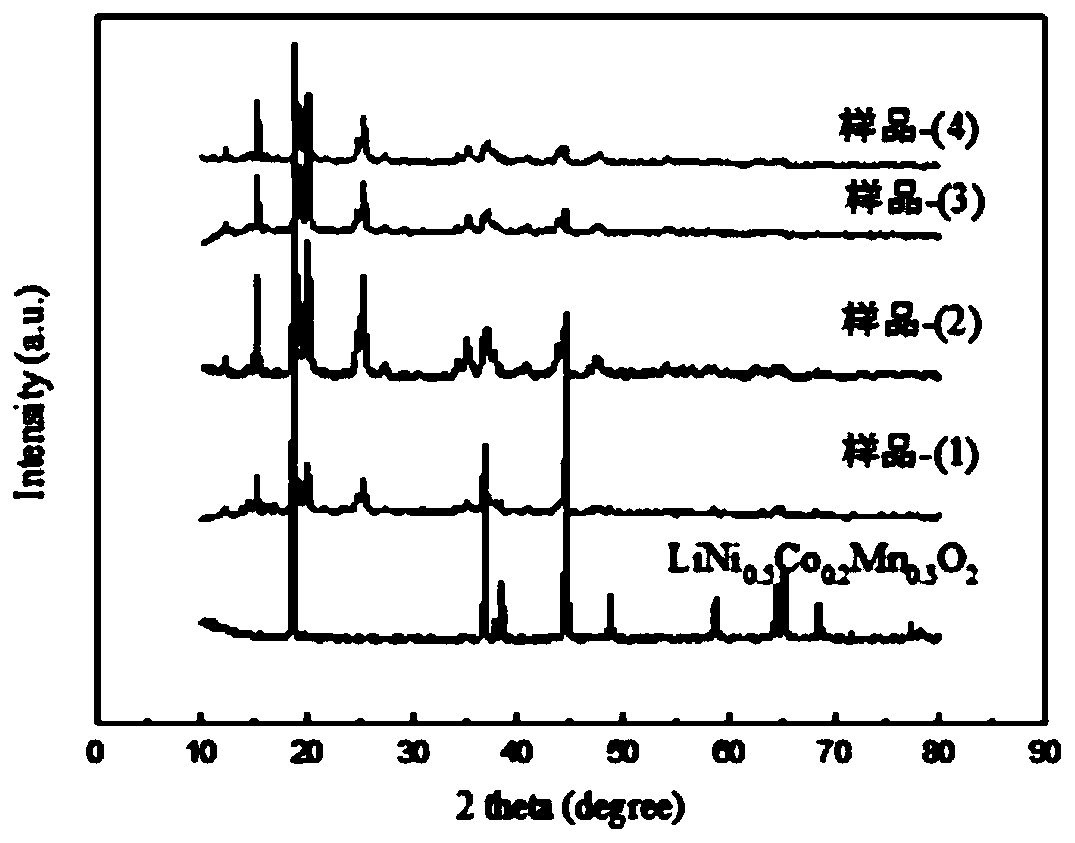Process for selectively extracting valuable metals in waste power lithium battery and repreparing ternary positive electrode material
A cathode material and valuable metal technology, which is applied in the field of effective recovery of valuable metals from waste batteries, can solve problems such as pollution and low cost, and achieve the effects of solving resource shortages, saving recycling costs, and avoiding secondary pollution.
- Summary
- Abstract
- Description
- Claims
- Application Information
AI Technical Summary
Problems solved by technology
Method used
Image
Examples
Embodiment 1
[0036] (1) Discharge, disassemble, ultrasonic stripping and calcination to obtain the required positive electrode material (LiNi 1 / 3 mn 1 / 3 CoO 2 ).
[0037](2) Weigh the required ternary materials, put them into a three-necked flask, use a water bath to control the reaction temperature, add the required acid content and hydrogen peroxide, and start timing. The concentration of oxalic acid is 0.2mol / L, the temperature is 40°C, the time is 20min, the hydrogen peroxide is 1vol.%, the liquid-solid ratio is 20mL / g, and the stirring speed is 400rpm, and the Li-containing supernatant and nickel-cobalt-manganese precipitate will be obtained. of the suspension.
[0038] (3) Filter the suspension obtained above using a vacuum filter, and repeatedly rinse the precipitate with distilled water 3 times to obtain the precipitate and leachate respectively, dry the obtained precipitate in an oven at 80°C for 10 hours, and then Grind and store in an agate mortar, record the volume of the s...
Embodiment 2
[0043] (1) Discharge, disassemble, ultrasonic stripping and calcination to obtain the required positive electrode material (LiNi 1 / 3 mn 1 / 3 COO 2 ).
[0044] (2) Design a single factor experiment for oxalic acid leaching ternary materials, weigh the required ternary materials, put them into a three-necked flask, use a water bath to control the reaction temperature, add the required acid content and hydrogen peroxide, and start timing. Wherein the acid concentration is 0.5mol / L, the temperature is 50°C, the time is 30min, the hydrogen peroxide is 3vol.%, and the liquid-solid ratio is 40mL / g, a supernatant containing Li and a suspension containing nickel, cobalt and manganese precipitates will be obtained.
[0045] (3) Filter the suspension obtained above using a vacuum filter, and repeatedly rinse the precipitate with distilled water 3 times to obtain the precipitate and leachate respectively, dry the obtained precipitate in an oven at 80°C for 10 hours, and then Grind and s...
Embodiment 3
[0050] (1) Discharge, disassemble, ultrasonic stripping and calcination to obtain the required positive electrode material (LiNi 1 / 3 mn 1 / 3 COO 2 ).
[0051] (2) Design a single factor experiment for oxalic acid leaching ternary materials, weigh the required ternary materials, put them into a three-necked flask, use a water bath to control the reaction temperature, add the required acid content and hydrogen peroxide, and start timing. The acid concentration is 1.0mol / L, the temperature is 80°C, the time is 60min, the hydrogen peroxide is 5vol.%, and the liquid-solid ratio is 60mL / g, and a suspension containing Li-containing supernatant and nickel-cobalt-manganese precipitate will be obtained.
[0052] (3) Filter the suspension obtained above using a vacuum filter, and repeatedly rinse the precipitate with distilled water 3 times to obtain the precipitate and leachate respectively, dry the obtained precipitate in an oven at 80°C for 10 hours, and then Grind and store in an a...
PUM
| Property | Measurement | Unit |
|---|---|---|
| acid concentration | aaaaa | aaaaa |
Abstract
Description
Claims
Application Information
 Login to View More
Login to View More - R&D
- Intellectual Property
- Life Sciences
- Materials
- Tech Scout
- Unparalleled Data Quality
- Higher Quality Content
- 60% Fewer Hallucinations
Browse by: Latest US Patents, China's latest patents, Technical Efficacy Thesaurus, Application Domain, Technology Topic, Popular Technical Reports.
© 2025 PatSnap. All rights reserved.Legal|Privacy policy|Modern Slavery Act Transparency Statement|Sitemap|About US| Contact US: help@patsnap.com



